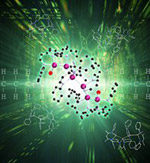|
Metals Take on Carbon's Bonding Characteristics
 | |
| Mike Hill | |
A rethink about chemical bonding might be in the cards thanks to research that shows that the metal indium forms bonds in a manner not dissimilar to organic carbon atoms. Extended, or catenated, chains of atoms are common in carbon compounds, but UK chemists have found that they can make chains of indium atoms linked by single bonds.
Chemist Mike Hill and Ruti Pongtavornpinyo of Imperial College London and Peter Hitchcock of the University of Sussex, have discovered an unusual electronic structure in the metal indium that opens up the possibility of designing polymers based on group 13 elements. The discovery could lead to a new class of materials for electronic components that side-step the semiconductors, such as silicon and germanium. New types of light emitting diodes (LEDs) and solar cells might be possible.
The researchers created the novel indium compound, which contains six indium atoms in a chain, through an exchange reaction between indium monoiodide and a potassium derivative modulated by protonated N-xylyl beta-diketiminate. The team used X-ray crystallography to determine the structure and found that one beta-diketiminate ligand is bound to each indium center and importantly no bridging ligands support the five single bonds between the metal atoms. Iodine caps the terminal indium atoms.
Hill explains that, "The compound that we made was unexpectedly stable and it was very simple to create. It opens up another box for finding solutions to a host of problems." A soluble polymer based on indium, for instance, could be sprayed on to a substrate as a solution, removing the need to use the inconveniently high temperatures and low pressures that are required when making entirely solid-state electronic devices.
 | |
The researchers hope to study the new molecules in more depth to see if they are able to create longer and shorter chains of group 13 atoms and ultimately create stable polymers. "If you think of the elements in the periodic table as a set of paints, people tend to use only certain colours from the palette," Hill adds, "Here, we're using shades that aren't normally used. This opens up possibilities in terms of the way we can start to control these natural elements and make them work for us in ways that they wouldn't do in nature."
Science, 2006, 311, 1904-1907; http://dx.doi.org/10.1126/science.1123945
http://www3.imperial.ac.uk/people/mike.hill
http://www.sussex.ac.uk/chemistry/profile1244.html
|

